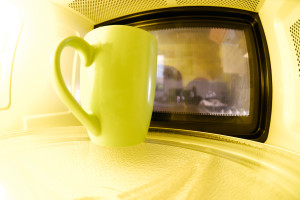 Since the home microwave first hit the nation’s worktops in 1967, there have been a whole host of myths and old wives tales associated with this amazingly useful piece of space-age technology. Luckily, here at Microwavable we know all there is to know about microwave myths, microwave facts and microwave horror stories, and we’re here to give you the straight dope. So, without further ado, here are our top 5 microwave myths, exploded!
Since the home microwave first hit the nation’s worktops in 1967, there have been a whole host of myths and old wives tales associated with this amazingly useful piece of space-age technology. Luckily, here at Microwavable we know all there is to know about microwave myths, microwave facts and microwave horror stories, and we’re here to give you the straight dope. So, without further ado, here are our top 5 microwave myths, exploded!
1: Metal Gets Dangerously Hot In a Microwave
The classic microwave myth is that metal – whether cutlery, foil or a metal container cannot be put in a microwave or else it will heat to a terrifying temperature, and possibly cause an explosion. The truth is less dramatic, but more fascinating: due to its reflective qualities, metals actually reflect microwaves, meaning that they heat up less than plastics, glass, ceramics and food products. Metal is only dangerous in a microwave when it is shaped wrongly: if it contains acute angles (less than 90 degrees) these can act as antenna, causing arcs of electricity which may be earthed in flammable foodstuffs and cause fire. This is why it’s best to avoid putting metal objects in the microwave.
2: Microwaves Cook Food From The Inside Out
Ask most people how a microwave works and they’ll say that it cooks from the inside out, but this is not true. In fact, microwaves heat by making water molecules on the outside of the food vibrate. Microwaves can only affect the outer layers of food, which is why if you try and cook a huge chunk of meat in a microwave the centre will always come out raw.
3: Microwaves Can Leak Radiation
Many people worry that their microwave oven is like a dangerous nuclear reactor that they keep in their kitchen. Luckily for us all, this is not the case. Even a faulty microwave is only capable of emitting around 5 milliwatts of radiation per square centimetre over the course of their entire lifespan. This is far, far, far below the level which is harmful to humans, so don’t worry – the worst thing a faulty microwave can cause is an unevenly cooked pie. This is why microwave sterilisers
are considered the safest way to keep your baby’s foodware bacteria-free.
4: Microwaves Alter the Chemical Structure of Foods
Since microwaves cook at astonishing speeds, many people suspect them of cheating in some way, and of having a negative effect on the food that’s cooked. A microwave simply heats up the water in food, which has the effect of heating at an accelerated rate without burning. This gives a different result to ordinary cooking, but it does not mean that anything sinister has happened. Some foods respond well to microwave cookery, some don’t. Luckily, Annette Yates’ excellent Microwave Cooking Properly Explained
can help you work out what works.
5: You Can’t Microwave Bacon
If you’ve got any other microwave myths you’d like us to bust, let us know in the comments section below!